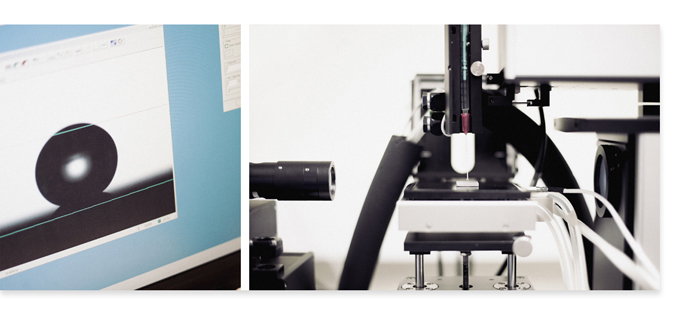 A water droplet on a superhydrophobic surface.
A water droplet on a superhydrophobic surface.
The build-up of ice and frost is a big problem in many industrial applications. On cold climate sites around the world icing has a negative influence on the energy production. Can we call on the help of nanotechnology to solve some of the problems?
Together with Saab, Nibe, Electrolux, Vattenfall, and several research partners in the Nordic countries, YKI develop nanoscale coatings and surface treatments to prevent and combat the formation of frost and ice.
We evaluate coatings to minimize ice growth and adhesion. One of the lead ideas in the development of anti-icing coatings is the use of strong water-repellent surfaces, so called superhydrophobic coatings. Such coatings combine a hydrophobic surface chemistry with a suitable surface roughness, which results in a minimized solid-liquid contact area for a water droplet in contact with the surface. The idea behind this concept in anti-icing applications is that water droplets bounce off the surface before they freeze, or that the ice adhesion strength is reduced due to the low solid-ice contact area.
Superhydrophobic surfaces have shown promising properties as anti-icing surfaces in a range of studies1-3. However, such surfaces are not necessarily the solution against icing in all weather conditions. At high humidity, the risk of frost formation and water condensation in the rough surface structure of superhydrophobic surfaces is relatively high, which has resulted in high ice adhesion strength due to the high solid-ice contact area4-6. Another challenge with superhydrophobic coatings is to improve the long-term stability, which is governed by e.g. the robustness of the coating and the adhesion to the substrate.
Winter Field Tests Are Being Planned
We are now about mid-way through the project and have built up new methodologies and tested a range of different surface treatments and coatings. The last two winter seasons of the project is planned to include field tests, and we are currently preparing for tests at a wind park of a participating industrial partner. Having already pre-tested these surfaces in the laboratory, we will follow the formation of ice at our partner’s site using samples mounted on a met mast. We will run lab tests in parallel and hope to be able to present some initial findings at Winterwind 2013.
A Multi-Disciplinary Approach Of Great Industrial And Societal Value
Of course, build-up of ice and frost affect several other important societal functions as well as our energy supply. We have delays, traffic jams and accidents. Aeroplanes, wind turbines, ships, roads, bridges and power supplies are affected. YKI is currently working on three target areas specifically: wind energy, aircrafts and heat exchanger applications. For the participating industrial companies, the TopNANO project runs in parallel with already existing projects and activities in wind turbine, aircraft and heat exchanger applications. Of key importance for TopNANO is the development of new materials and methods through direct industry-academia collaborations and the transfer of knowledge to Nordic industry.
We invite you to an annual seminar to discuss challenges and opportunities in the area. This year the one-day seminar is on November 13 at Aarhus University, with presentations both from the project and from external contacts.
This is a guest post by one of our partners.
![]()
About TopNANO
The Swedish part of the research performed by YKI, KTH Royal Institute of Technology and SP Technical Research Institute of Sweden focus on robust ice-repelling nanotech surfaces and surface spectroscopy analyses. Finnish VTT brings expertise on the physics of ice. Aarhus University in Denmark and their iNano centre works on mimicking nature’s way of avoiding freezing inside cells. TopNANO engages senior scientists, postdocs and PhD students.
The TopNANO project www.topnano.se started in 2010 and finishes in 2014 and has a grant from Nordic Innovation funding agency through the Top-level Research Initiative. It has a budget of 35 million Swedish crowns or 3,8 million Euros.
References
1. P. Tourkine, M. Le Merrer, D. Quere, Langmuir 2009, 25, 7214-7216., Delayed freezing on water repellent materials.
2. L. Mischenko et al., ACS Nano 2010, 4, 7699-7707., Design of ice-free nanostructured surfaces based on repulsion of impacting water droplets.
3. L. Cao et al., Langmuir 2009, 25, 12444-12448., Anti-icing superhydrophobic coatings.
4. S. A. Kulinich et al., Langmuir 2011, 27, 25-29. , Superhydrophobic surfaces: Are they really ice-repellent?
5. K. K. Varanasi et al., Appl. Phys. Lett. 2010, 97, 234102., Frost formation and ice adhesion on superhydrophobic surfaces.
6. S. Jung et al., Langmuir 2011, 27, 3059-3066., Are superhydrophobic surfaces best for icephobicity?